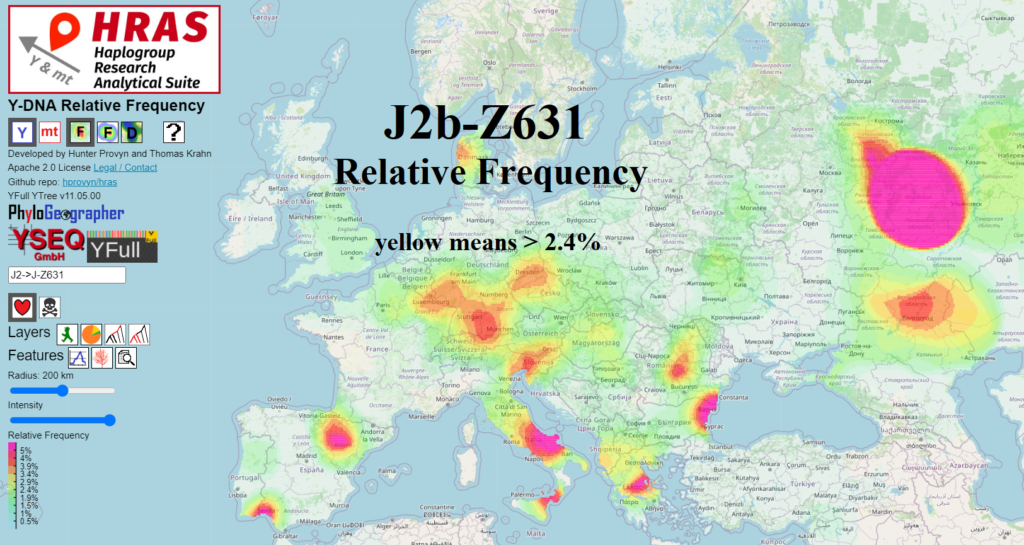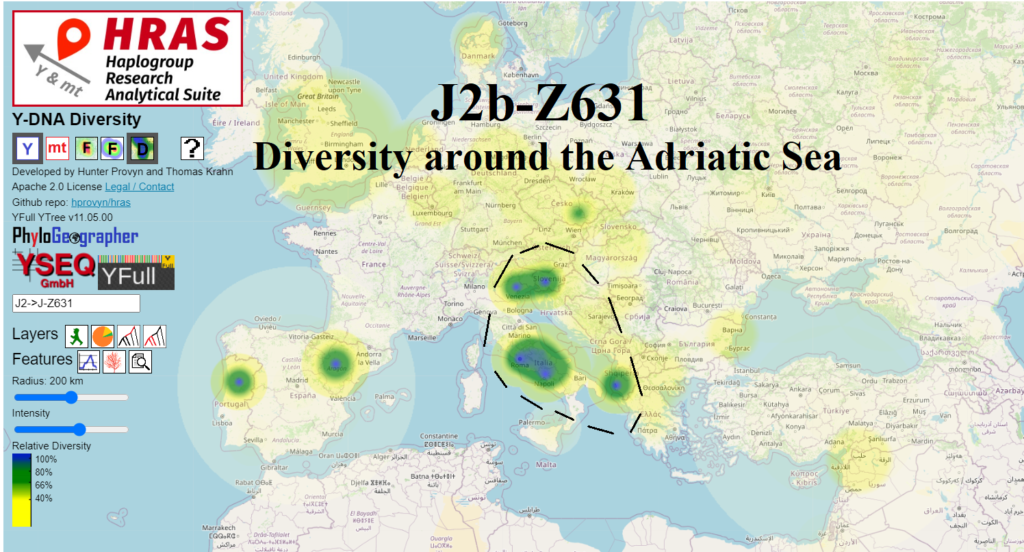J2b-L283>Z631>FT101890 is a rare lineage of prolific, Iron Age J2b-Z631 that had, until now, only been found in men tracing their male lines to the British Isles. Now it has been found in a man tracing his male line to Simonetta of Pettineo, Palermo, Sicily. That this line could have a presence in Sicily today comes as no surprise, given that most lines of J2b-L283 diversified in the western and central Balkans in the Bronze Age.
However, J2b-FT101890’s previous, British Isles-only distribution was misleading in the years before the discovery of a multitude of Bronze and Iron Age ancient samples from the western and central Balkans and parts of Italy in nearly every branch of J2b-L283.
The previous, British Isles-only distribution of this line was the result of relative oversampling of the populations of the British Isles, the relatively high fitness of male lines established by soldiers or other men who assisted the Romans in conquering and administering the province of Britannia (i.e. they didn’t die out after successive groups conquered England) or those who came later, and the possible extinction or displacement of J2b-FT101890 descendants in their Iron Age homeland that we may assume is somewhere in the southwestern or central Balkans in the rough area of the Iron Age Glasinac-Mati culture.
Iron Age J2b-FT101890
YFull estimates that the Most Recent Common Ancestor (MRCA) of J2b-FT101890 lived around 900 BCE.
On the YFull tree, we can see that J2b-FT101890 has two child lineages. The first child line has a TMRCA of about 800 years ago and the second has a TMRCA of 2900 years ago.
So in total there are three different lines of J2b-FT101890 that are about 2900 years distantly related to one another:
- J2b-FT101890>FT99882 men who descend from an MRCA who lived 800 years ago
- First sample of J2b-FT101890>Y136384 from England
- Second sample of J2b-FT101890>Y136384 from England
The sample from Sicily who is positive for this line has not yet done WGS or Big Y testing so all we know is that these other J2b-FT101890 men are more closely related to him than to men of other branches of J2b-L283. They share no rare STR alleles in the 37 that can be compared.
We plan to test this sample for one of the SNPs defining child line J2b-Y136384 at YSEQ as soon as the primers are available. The test for this SNP, BY70392, can be ordered here – https://www.yseq.net/product_info.php?products_id=388011
My old theory of a Central European homeland for J2b-Z631 (abandoned a few years ago in light of new evidence)
When I first got involved in J2b-L283 haplogroup research, several years ago, we didn’t have the corpus of ancient J2b-L283 samples dating to the Bronze and Iron Age that we do now. J2b-Z631 in particular happened to be one line that, until the last several years, was not well-represented in the Balkans.
Given that J2b-Z631 descendants (most of whom, including me, fall under the prolific child line J2b-Z1043) today have such a wide distribution throughout Europe, especially Central Europe, I had thought that the homeland of this line may have corresponded with Central Europe, which at that time was mostly inhabited by Celtic tribes.
While we still lack the Iron Age ancient samples to finally disprove this origin theory, for the last few years we have several strong reasons for assuming that this lineage actually originated in the Balkans (with the rest of surviving J2b-L283 lines):
- Based on Bronze Age ancient samples, the major branch of J2b-L283 to which J2b-Z631 belongs, known as J2b-Z638, appears to have diversified southeast of Dubrovnik-Neretva County. So given that this is the opposite direction of Central Europe, Central Europe is therefore less likely to be an Iron Age homeland of a line of J2b-Z638 (relative to its sibling).
- The only Iron Age J2b-L283 sample found in Central Europe, I4998, is positive for much rarer J2b-BY161113 and not the prolific J2b-Z631. The sample dates from 391-208 BCE and was found in Vas County, Hungary in a La Tene archaeological context. If J2b-Z631 had actually originated in this area, it would have been much more likely to have been found vs significantly less prolific J2b-BY161113. Flor Veseli maintains this map of ancient J2b-L283 samples which I find to be an invaluable resource for J2b-L283 research.
- Increasing modern diversity of J2b-Z631 found in the Balkans. The most recent additions include a sample from Njeguši, Montenegro (not yet completed WGS) and YF125110, an ethnic Albanian from Kicevo, North Macedonia. Both are in different lines of J2b-Z1043>FGC55778, which already had high southwest Balkan diversity in an Iron Age line.
To assume Roman-mediated migration for almost any line of J2b-L283 is not “going out on a limb”
Several years ago, I thought that one would be going out on a limb to assume that nearly the entire distribution of J2b-Z1043 that is north or west of the Balkans was due to Roman-mediated migration. After all, this lineage comprises 2.4-4% of the male lines over large swathes of Central Europe. It would seem improbable that an Iron Age line that most likely didn’t originate in Rome would end up making this big of a Y-DNA footprint in Central Europe thanks to the Romans.
However this seems to have been the case. Note that some of the high distribution in Baden-Württemberg (six samples of the eight on YFull below J2b-Z631) is due to a founding effect of one line about 1450 years ago.

A useful tool for viewing the geographic distribution of a haplogroup that is not influenced by founder effects is the diversity map mode of HRAS.

According to the diversity map, the areas surrounding the Adriatic Sea exhibit much higher diversity for J2b-Z631 than Central Europe does.
Illyrian vs Italian Y-DNA in the Roman Empire
If J2b-L283 was the principal male line of most Illyrian tribes, then once all native Italian/Roman male lines have been identified, it will be possible to compute the ratio to which Illyrians contributed to the Y-DNA of different regions of the Roman Empire vs Romans who originated in other parts of the Roman Empire, such as the Italian Peninsula.
There will be some fuzziness here disambiguating “Italian” vs “Illyrian” because of the proximity of Italy and the western Balkans – for instance some lines of J2b-L283 have been found in ancient samples in Italy since the earliest part of the Iron Age. So some fraction of J2b-L283 that underwent Roman-mediated migration to elsewhere in Europe may have been born on the Italian peninsula – those we would want to count as having originated in Italy for the purposes of comparing Illyrian tribes vs native Italians’ contribution to the Y-DNA makeup of Roman conquered lands.
The Y-DNA of Italy in general is not my area of specialization but others could use HRAS as one resource to help with this computation.
These posts are the opinion of Hunter Provyn, a haplogroup researcher in J-M241 and J-M102.